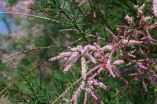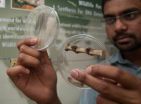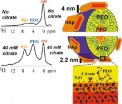(Press-News.org) Trees are often viewed as individuals that compete with one another for access to limited resources. But could trees in stressed environments actually benefit from positive, facultative interactions? The authors of a new paper suggest that might be the case for certain tree species—and that it may take the form of root grafting.
Natural root grafting between individuals has been observed in over 150 species of plants around the world. However, while much is known about benefits of merging stem tissues (primarily from horticultural practices), little is known about why plants may merge, or graft, their root tissues with one another.
Emilie Tarroux and Annie DesRochers, from the Université du Québec in Abitibi-Témiscamingue, Canada, were interested in determining if root grafting conferred any advantages to individual jack pine (Pinus banksiana) trees. Although the joining of tree root systems can confer advantages such as increased wind stability and sharing of resources e.g., water, photosynthates, or nutrients, Tarroux and DesRochers are the first to show how root grafting affects the growth of trees. They published their findings in the June issue of the American Journal of Botany (http://www.amjbot.org/content/98/6/967.full).
"Trees, even seed-regenerated ones like jack pine, are not independent individuals," DesRochers commented, "and may directly affect growth of their neighbors by forming root grafts."
After felling select jack pine trees in three natural stands and three plantations, Tarroux and DesRochers hydraulically excavated their root systems using a high-pressure water spray to determine if the trees had root grafts. They then aged the trees, roots, and grafts by counting and cross-dating their respective growth rings.
Interestingly, the authors found that radial growth patterns differed between jack pine trees growing naturally versus those grown in plantations. In the natural stands, there were more root grafts per individual tree than in the plantations, and growth of these trees slowed down when they were forming root grafts with other trees, but then resumed or gradually increased their rate of growth once the root graft was established. In contrast, root grafting in the evenly spaced plantations seemed to have less of an effect on growth rates.
The authors also discovered that trees which would later form root grafts tended to have better growth rates compared with trees that did not form root grafts, even prior to graft formation. Individuals may need to become large enough in order to have enough energy to complete a root graft, or so their root systems are able to come into contact with those of other trees. Conversely, smaller, weaker trees may lack energy to form root grafts, or they may not have very extensive root systems.
So what are some of the advantages of joining root systems with another tree?
"Root grafting could give an evolutionary advantage to the species," said DesRochers. "For example, it could allow well-located trees to support trees that grow in drier or poorer environments. This has been known for herbaceous species that propagate vegetatively, but has rarely been addressed in trees."
Indeed, if the larger trees facilitated acquisition of resources among conspecifics in the stand, they could maintain stand integrity; supplying carbohydrates to suppressed trees could deter tree death that would create gaps in the stand which would then allow other species to invade. Such root grafting behavior could be viewed as the formation of a communal root system, enhancing conspecific growth within the stand. This challenges the typical competition outlook, and could be interpreted as an intraspecific cooperative behavior that maintains stand integrity.
"Interestingly, we also found a couple of root grafts between jack pine and black spruce during the excavation of the sites," noted DesRochers. "Mentions of interspecific grafts are absent from the literature and makes us question the evolutionary significance of these grafts. Unfortunately, we haven't found any more since—and we have searched!."
"The next step in our research is to study the ecological significance of these root grafts," concludes DesRochers. "Among other things, we'd like to see how much, how far, and what substances (photosynthates, water, hormones, etc.) are shared between interconnected trees."
INFORMATION:
Tarroux, Emilie, and Annie DesRochers. (2011). Effect of natural root grafting on growth response of jack pine (Pinus banksiana; Pinaceae). American Journal of Botany 98(6): 967-974. DOI: 10.3732/ajb.1000261
The full article in the link mentioned is available for no charge for 30 days following the date of this summary at http://www.amjbot.org/content/98/6/967.full. After this date, reporters may contact Richard Hund at ajb@botany.org for a copy of the article.
The Botanical Society of America (www.botany.org) is a non-profit membership society with a mission to promote botany, the field of basic science dealing with the study and inquiry into the form, function, development, diversity, reproduction, evolution, and uses of plants and their interactions within the biosphere. It has published the American Journal of Botany (www.amjbot.org) for nearly 100 years. In 2009, the Special Libraries Association named the American Journal of Botany one of the Top 10 Most Influential Journals of the Century in the field of Biology and Medicine.
For further information, please contact the AJB staff at ajb@botany.org.
Is root grafting a positive, cooperative behavior in trees?
Despite being costly to initiate, root grafting can increase radial growth in jack pine trees
2011-06-09
ELSE PRESS RELEASES FROM THIS DATE:
Anthropologists study autobiographies in Basque of people who took part in the Spanish War
2011-06-09
They say that history is written by the victors. But the combatants, fundamental to the outcome of war, rarely appear in this history – whether victors or vanquished. University of the Basque Country anthropologists Pío Pérez and Ignazio Aiestaran have rebelled against this injustice, "uncovering" the memory of those who fought in the trenches in the 1936 war in Spain. They studied ten autobiographical accounts to produce Oroimen iheskorrak: gerra zibileko sufrimenduaren inguruko hausnarketak, euskaraz idatzitako testigantzen ikerketaren bitartez (Elusive memories: thoughts ...
Lack of relationships, education top list of common American regrets
2011-06-09
Los Angeles, CA (June 8, 2011) Regrets—we've all had a few. Although too many regrets can interfere with life and mental health, a healthy amount of regret can motivate us to improve our lives, say researchers Mike Morrison of the University of Illinois and Neal Roese of Northwestern University in the current issue of Social Psychological and Personality Science (published by SAGE).
The researchers telephoned a representative sample of nearly 400 Americans to ask them about what they regret. The most frequent regrets of Americans are about love, education, and work. ...
Jellyfish blooms transfer food energy from fish to bacteria
2011-06-09
Jellyfish can be a nuisance to bathers and boaters in the Chesapeake Bay on the United States' East Coast and many other places along the world's coasts.
A new study by researchers at the Virginia Institute of Marine Science (VIMS) shows that jellyfish also have a more significant impact, drastically altering marine food webs by shunting food energy toward bacteria.
An apparent increase in the size and frequency of jellyfish blooms in coastal and estuarine waters around the world during the last few decades means that jellies' impact on marine food webs is likely to ...
Penn researchers develop biological circuit components, new microscope technique for measuring them
2011-06-09
PHILADELPHIA — Electrical engineers have long been toying with the idea of designing biological molecules that can be directly integrated into electronic circuits. University of Pennsylvania researchers have developed a way to form these structures so they can operate in open-air environments, and, more important, have developed a new microscope technique that can measure the electrical properties of these and similar devices.
The research was conducted by Dawn Bonnell, Trustee Chair Professor and director of the Nano/Bio Interface Center, graduate students Kendra Kathan-Galipeau ...
New 3-D tumor model
2011-06-09
College Park, Md. (June 08, 2011) – A team of scientists has developed a way to coax tumor cells in the lab to grow into 3-D spheres. Their discovery takes advantage of an earlier technique of producing spherical cavities in a common polymer and promises more accurate tests of new cancer therapies.
As team leader Michael R. King, Ph.D., of Cornell University explains, "Sometimes engineering research tends to be a case of a hammer looking for a nail. We knew our previous discovery was new and it was cool. And now we know it's useful."
Three years ago, the team -- in ...
Ecology biased against non-native species?
2011-06-09
The recent field of invasion biology faces a new challenge as 19 eminent ecologists issue a call to "end the bias against non-native species" in the journal Nature.
Often called aliens, hitchhikers or invasives, some scientists say that non-native species could just as easily be coined "abductees" whose transport links to activities by humans.
The authors of the Nature comments section note that assumptions that "introduced species" offer only deleterious impacts are misguided and "that human-induced impacts, such as climate change, nitrogen eutrophication, urbanization ...
Saving wildlife with forensic genetics
2011-06-09
Wildlife face many threats with spreading urbanization, including habitat loss and inbreeding when populations become fragmented and isolated. It doesn't help that there is a billion-dollar international industry dedicated to the illegal trafficking of wild animals or wild animal parts.
The Conservation Genetics Lab at the University of Arizona is working to conserve and protect wild animals around the world.
"Our work here deals with using genetics for wildlife conservation," said Ashwin Naidu, a doctoral candidate in the School of Natural Resources and the Environment.
One ...
Researchers discover superatoms with magnetic shells
2011-06-09
RICHMOND, Va. (June 8, 2011) – A team of Virginia Commonwealth University scientists has discovered a new class of 'superatoms' – a stable cluster of atoms that can mimic different elements of the periodic table – with unusual magnetic characteristics.
The superatom contains magnetized magnesium atoms, an element traditionally considered as non-magnetic. The metallic character of magnesium along with infused magnetism may one day be used to create molecular electronic devices for the next generation of faster processors, larger memory storage and quantum computers.
In ...
Lifelong gap in health between rich and poor set by age 20
2011-06-09
"We can't buy our way out of ageing," says Nancy Ross, a McGill geography professor. "As we get older we start to have vision problems, maybe some hearing loss, maybe lose some mobility – ageing is a kind of a social equalizer."
Ross is the lead author of a new study about how socio-economic and educational status affects Canadians' health-related quality of life over the course of a lifetime.
"My research looks at how poverty and social disadvantage affect your health status. Our work was about using social circumstances as a lens to look at how people's quality ...
Citrate key in bone's nanostructure
2011-06-09
AMES, Iowa - Bone is one of nature's surprising "building materials." Pound-for-pound it's stronger than steel, tough yet resilient. Scientists at the U.S. Department of Energy's Ames Laboratory have identified the composition that gives bone its outstanding properties and the important role citrate plays, work that may help science better understand and treat or prevent bone diseases such as osteoporosis.
Using nuclear magnetic resonance (NMR) spectroscopy, Ames Laboratory scientist and Iowa State University chemistry professor Klaus Schmidt-Rohr and his colleagues ...
LAST 30 PRESS RELEASES:
Interaction of climate change and human activity and its impact on plant diversity in Qinghai-Tibet plateau
From addressing uncertainty to national strategy: an interpretation of Professor Lim Siong Guan’s views
Clinical trials on AI language model use in digestive healthcare
Scientists improve robotic visual–inertial trajectory localization accuracy using cross-modal interaction and selection techniques
Correlation between cancer cachexia and immune-related adverse events in HCC
Human adipose tissue: a new source for functional organoids
Metro lines double as freight highways during off-peak hours, Beijing study shows
Biomedical functions and applications of nanomaterials in tumor diagnosis and treatment: perspectives from ophthalmic oncology
3D imaging unveils how passivation improves perovskite solar cell performance
Enriching framework Al sites in 8-membered rings of Cu-SSZ-39 zeolite to enhance low-temperature ammonia selective catalytic reduction performance
AI-powered RNA drug development: a new frontier in therapeutics
Decoupling the HOR enhancement on PtRu: Dynamically matching interfacial water to reaction coordinates
Sulfur isn’t poisonous when it synergistically acts with phosphine in olefins hydroformylation
URI researchers uncover molecular mechanisms behind speciation in corals
Chitin based carbon aerogel offers a cleaner way to store thermal energy
Tracing hidden sources of nitrate pollution in rapidly changing rural urban landscapes
Viruses on plastic pollution may quietly accelerate the spread of antibiotic resistance
Three UH Rainbow Babies & Children’s faculty elected to prestigious American Pediatric Society
Tunnel resilience models unveiled to aid post-earthquake recovery
Satellite communication systems: the future of 5G/6G connectivity
Space computing power networks: a new frontier for satellite technologies
Experiments advance potential of protein that makes hydrogen sulfide as a therapeutic target for Alzheimer’s disease
Examining private equity’s role in fertility care
Current Molecular Pharmacology achieves a landmark: real-time CiteScore advances to 7.2
Skeletal muscle epigenetic clocks developed using postmortem tissue from an Asian population
Estimating unemployment rates with social media data
Climate policies can backfire by eroding “green” values, study finds
Too much screen time too soon? A*STAR study links infant screen exposure to brain changes and teen anxiety
Global psychiatry mourns Professor Dan Stein, visionary who transformed mental health science across Africa and beyond
KIST develops eco-friendly palladium recovery technology to safeguard resource security
[Press-News.org] Is root grafting a positive, cooperative behavior in trees?Despite being costly to initiate, root grafting can increase radial growth in jack pine trees




